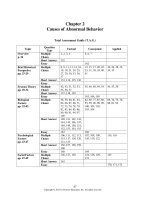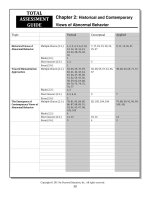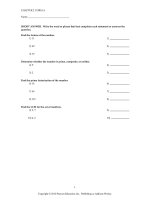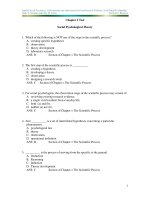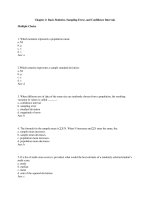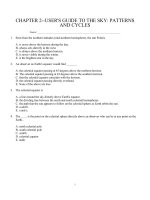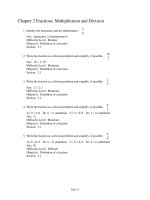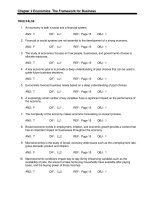Experience psychology 2nd edition king test bank
Bạn đang xem bản rút gọn của tài liệu. Xem và tải ngay bản đầy đủ của tài liệu tại đây (233.34 KB, 40 trang )
Chapter 02 - The Brain and Behavior
Chapter 02
The Brain and Behavior
Multiple Choice Questions
1. (p. 43) The _____ system is the body's electrochemical communication circuitry.
A. pulmonary
B. nervous
C. endocrine
D. respiratory
Blooms: Remember
Difficulty: Easy
Learning Objectives: The Nervous System
2. (p. 43) A single cubic centimeter of the human brain consists of well over _____ nerve cells.
A. 50 million
B. 10 million
C. 30 billion
D. 20 billion
Blooms: Remember
Difficulty: Easy
Learning Objectives: The Nervous System
3. (p. 43) Which of the following characteristics of the nervous system best reflects the brain's
ability to coordinate information from all five senses?
A. Complexity
B. Adaptability
C. Integration
D. Electrochemical transmission
Blooms: Understand
Difficulty: Medium
Learning Objectives: The Nervous System
2-1
© 2013 by McGraw-Hill Education. This is proprietary material solely for authorized instructor use. Not authorized for sale or distribution in
any manner. This document may not be copied, scanned, duplicated, forwarded, distributed, or posted on a website, in whole or part
Chapter 02 - The Brain and Behavior
4. (p. 44) The term plasticity refers to the _____.
A. flexibility of the endocrine system
B. ability of people to adapt to new surroundings
C. ability to connect electrical impulses and chemical messengers
D. brain's special capacity for modification and change
Blooms: Remember
Difficulty: Easy
Learning Objectives: The Nervous System
5. (p. 44) Plasticity best reflects which of the following characteristics of the nervous system?
A. Complexity
B. Integration
C. Adaptability
D. Electrochemical transmission
Blooms: Understand
Difficulty: Medium
Learning Objectives: The Nervous System
6. (p. 44) You are listening to a lecture. Then the bell rings in the hallway. In order to hear this
stimulus, _____ neurons must carry electrochemical messages from your ears to your brain.
A. afferent
B. olfactory
C. efferent
D. pyramidal
Blooms: Apply
Difficulty: Medium
Learning Objectives: The Nervous System
2-2
© 2013 by McGraw-Hill Education. This is proprietary material solely for authorized instructor use. Not authorized for sale or distribution in
any manner. This document may not be copied, scanned, duplicated, forwarded, distributed, or posted on a website, in whole or part
Chapter 02 - The Brain and Behavior
7. (p. 44) The lecture you were listening to is over. The bell that rang in the hall signaled the end
of class. You get up out of your seat, pick up your things, and walk out the classroom door.
Which kind of nerves sent the signals from your brain to your muscles to initiate your
physical movements?
A. Afferent
B. Pyramidal
C. Efferent
D. Olfactory
Blooms: Apply
Difficulty: Medium
Learning Objectives: The Nervous System
8. (p. 44) Information from the brain and spinal cord to the muscles is sent through _____, thus
enabling the body to move.
A. afferent nerves
B. efferent nerves
C. pyramidal nerves
D. olfactory nerves
Blooms: Remember
Difficulty: Easy
Learning Objectives: The Nervous System
9. (p. 44) Your brain has instructed your body muscles to move so that you avoid burning your
hand on a hot stove. Which type of nerves carried the information from your brain to your
muscles so that you could avoid getting burned?
A. Efferent nerves
B. Afferent nerves
C. Sensory nerves
D. Parasympathetic nerves
Blooms: Apply
Difficulty: Hard
Learning Objectives: The Nervous System
2-3
© 2013 by McGraw-Hill Education. This is proprietary material solely for authorized instructor use. Not authorized for sale or distribution in
any manner. This document may not be copied, scanned, duplicated, forwarded, distributed, or posted on a website, in whole or part
Chapter 02 - The Brain and Behavior
10. (p. 44) Joshua is reading a novel. The input from his eyes is transmitted to his brain and then
passed through many _____ that translate the character on the page to integrate sensory input
and motor output.
A. vesicles
B. myelin sheaths
C. synapses
D. neural networks
Blooms: Apply
Difficulty: Medium
Learning Objectives: The Nervous System
11. (p. 45) The brain and spinal cord make up the _____.
A. peripheral nervous system
B. central nervous system
C. autonomic nervous system
D. somatic nervous system
Blooms: Remember
Difficulty: Easy
Learning Objectives: The Nervous System
12. (p. 45) The _____ nervous system connects the brain and spinal cord to the rest of the body.
A. central
B. peripheral
C. somatic
D. autonomic
Blooms: Remember
Difficulty: Easy
Learning Objectives: The Nervous System
2-4
© 2013 by McGraw-Hill Education. This is proprietary material solely for authorized instructor use. Not authorized for sale or distribution in
any manner. This document may not be copied, scanned, duplicated, forwarded, distributed, or posted on a website, in whole or part
Chapter 02 - The Brain and Behavior
13. (p. 45) The somatic nervous system and autonomic nervous system are components of the
_____.
A. sensory system
B. central nervous system
C. limbic system
D. peripheral nervous system
Blooms: Remember
Difficulty: Medium
Learning Objectives: The Nervous System
14. (p. 45) The function of the somatic nervous system is to _____.
A. take messages to and from the body's internal organs, monitoring such processes as
breathing, heart rate, and digestion
B. tell muscles what to do
C. be involved in the experience of stress and calms the body
D. convey information from the skin and muscles to the CNS about conditions such as pain
and temperature
Blooms: Understand
Difficulty: Medium
Learning Objectives: The Nervous System
15. (p. 45) The function of the _____ is to take messages to and from the body's internal organs,
monitoring such processes as breathing, heart rate, and digestion.
A. central nervous system
B. autonomic nervous system
C. somatic nervous system
D. parasympathetic nervous system
Blooms: Remember
Difficulty: Easy
Learning Objectives: The Nervous System
2-5
© 2013 by McGraw-Hill Education. This is proprietary material solely for authorized instructor use. Not authorized for sale or distribution in
any manner. This document may not be copied, scanned, duplicated, forwarded, distributed, or posted on a website, in whole or part
Chapter 02 - The Brain and Behavior
16. (p. 45) Which of the following essential body functions are under the control of the
autonomic nervous system?
A. Functions of reproductive system
B. Excretory functions
C. Sensory functions such as vision and hearing
D. Heart rate, breathing, and digestion
Blooms: Understand
Difficulty: Medium
Learning Objectives: The Nervous System
17. (p. 45) The sympathetic nervous system and parasympathetic nervous system are
components of the _____.
A. central nervous system
B. endocrine system
C. somatic nervous system
D. autonomic nervous system
Blooms: Remember
Difficulty: Easy
Learning Objectives: The Nervous System
18. (p. 46) Which of the following is one of the functions of the sympathetic nervous system?
A. Convey information from skin and muscles to CNS
B. Calm the body
C. Fight-or-flight reaction
D. Influence somatic nervous system
Blooms: Understand
Difficulty: Medium
Learning Objectives: The Nervous System
2-6
© 2013 by McGraw-Hill Education. This is proprietary material solely for authorized instructor use. Not authorized for sale or distribution in
any manner. This document may not be copied, scanned, duplicated, forwarded, distributed, or posted on a website, in whole or part
Chapter 02 - The Brain and Behavior
19. (p. 46) You are walking to school when you encounter a strange barking dog. You start
sweating and contemplate whether you should run away. Which nervous system is responsible
for this "fight-or-flight" reaction?
A. Somatic
B. Sympathetic
C. Parasympathetic
D. Central
Blooms: Apply
Difficulty: Medium
Learning Objectives: The Nervous System
20. (p. 46) Just before you went on a job interview your heart was pounding like crazy. You
experienced a shortness of breath and felt sick to your stomach. These symptoms were most
likely produced by your _____ nervous system.
A. central
B. somatic
C. parasympathetic
D. sympathetic
Blooms: Apply
Difficulty: Hard
Learning Objectives: The Nervous System
21. (p. 46) Which division of the peripheral nervous system is responsible for producing
physiological symptoms (such as increased heart rate and butterflies in the stomach) under
conditions of stress?
A. Somatic
B. Parasympathetic
C. Sympathetic
D. Central
Blooms: Apply
Difficulty: Medium
Learning Objectives: The Nervous System
2-7
© 2013 by McGraw-Hill Education. This is proprietary material solely for authorized instructor use. Not authorized for sale or distribution in
any manner. This document may not be copied, scanned, duplicated, forwarded, distributed, or posted on a website, in whole or part
Chapter 02 - The Brain and Behavior
22. (p. 46) After finishing a psychology test, you try to relax by engaging in some meditation
techniques. Doing these exercises should increase the response of the _____ nervous system,
which results in a slower heart and respiration rate and less muscular tension.
A. somatic
B. central
C. parasympathetic
D. sympathetic
Blooms: Apply
Difficulty: Hard
Learning Objectives: The Nervous System
23. (p. 46) Corticosteroids are _____.
A. stress hormones
B. sex hormones
C. neurotransmitters that regulate mood
D. neurotransmitters that regulate memory
Blooms: Remember
Difficulty: Easy
Learning Objectives: The Nervous System
24. (p. 46) _____ stress is the momentary stress that occurs in response to life experiences.
A. Intrinsic
B. Differential
C. Chronic
D. Acute
Blooms: Remember
Difficulty: Easy
Learning Objectives: The Nervous System
2-8
© 2013 by McGraw-Hill Education. This is proprietary material solely for authorized instructor use. Not authorized for sale or distribution in
any manner. This document may not be copied, scanned, duplicated, forwarded, distributed, or posted on a website, in whole or part
Chapter 02 - The Brain and Behavior
25. (p. 47) Which of the following types of cells in the nervous system handle the informationprocessing function?
A. Neurons
B. Glial cells
C. Sclerenchyma cells
D. Myelin
Blooms: Remember
Difficulty: Easy
Learning Objectives: Neurons
26. (p. 47) _____ provide support, nutritional benefits, and other functions in the nervous
system.
A. Neurons
B. Glial cells
C. Sclerenchyma cells
D. Dendrites
Blooms: Remember
Difficulty: Easy
Learning Objectives: Neurons
27. (p. 49) The cell body contains the _____, which directs the manufacture of substances that a
neuron needs for growth and maintenance.
A. myelin
B. nucleus
C. axon
D. dendrite
Blooms: Remember
Difficulty: Easy
Learning Objectives: Neurons
2-9
© 2013 by McGraw-Hill Education. This is proprietary material solely for authorized instructor use. Not authorized for sale or distribution in
any manner. This document may not be copied, scanned, duplicated, forwarded, distributed, or posted on a website, in whole or part
Chapter 02 - The Brain and Behavior
28. (p. 49) The part of the neuron that contains the nucleus, which directs the manufacture of
substances that the neuron needs for growth and maintenance, is called the _____.
A. axon hillock
B. terminal stub
C. cell body
D. stem cell
Blooms: Remember
Difficulty: Easy
Learning Objectives: Neurons
29. (p. 49) Where is the nucleus of a neuron located?
A. axon hillock
B. terminal stub
C. dendrite
D. cell body
Blooms: Remember
Difficulty: Easy
Learning Objectives: Neurons
30. (p. 49) Dendrites are _____.
A. the part of the neuron that is responsible for sending information away from the cell body
toward other cells
B. the branch-like part of the neuron that is responsible for receiving information from other
neurons
C. located inside the cell body
D. the layer of fat cells that encase and insulate the neuron
Blooms: Remember
Difficulty: Easy
Learning Objectives: Neurons
2-10
© 2013 by McGraw-Hill Education. This is proprietary material solely for authorized instructor use. Not authorized for sale or distribution in
any manner. This document may not be copied, scanned, duplicated, forwarded, distributed, or posted on a website, in whole or part
Chapter 02 - The Brain and Behavior
31. (p. 49) The axon is _____.
A. the part of the neuron that is responsible for sending or carrying information away from the
cell body toward other cells
B. the branch-like part of the neuron that is responsible for receiving information from other
neurons
C. located inside the cell body
D. the layer of fat cells that encase and insulate the neuron
Blooms: Remember
Difficulty: Easy
Learning Objectives: Neurons
32. (p. 49) _____ is a layer of fat cells that insulates most axons and speeds up the transmission
of nerve impulses.
A. A dendrite
B. The myelin sheath
C. The axon
D. A nucleus
Blooms: Remember
Difficulty: Easy
Learning Objectives: Neurons
33. (p. 49) Which of the following is a function of the myelin sheath?
A. Carry information away from the cell body toward other cells
B. Increase the surface area of nerve cells
C. Speed up the transmission of nerve impulses
D. Play a role in imitation
Blooms: Understand
Difficulty: Medium
Learning Objectives: Neurons
2-11
© 2013 by McGraw-Hill Education. This is proprietary material solely for authorized instructor use. Not authorized for sale or distribution in
any manner. This document may not be copied, scanned, duplicated, forwarded, distributed, or posted on a website, in whole or part
Chapter 02 - The Brain and Behavior
34. (p. 50) Resting potential is the _____.
A. amount of time a signal travels through the central nervous system
B. amount of time a neuron must "rest" in between firing episodes
C. stable, positive charge of an inactive neuron
D. stable, negative charge of an inactive neuron
Blooms: Remember
Difficulty: Easy
Learning Objectives: Neurons
35. (p. 50) The membrane of the resting neuron is said to be _____.
A. deconcentrated
B. depolarized
C. concentrated
D. polarized
Blooms: Remember
Difficulty: Easy
Learning Objectives: Neurons
36. (p. 50) When a neuron is at its resting state, what is the status of the charges on each side of
the cell membrane?
A. There is a negative charge on the outside of the cell membrane, and a positive charge on
the inside.
B. There is a negative charge on the inside of the cell membrane and a positive charge on the
outside.
C. There is a negative charge on both the outside and the inside of the cell membrane.
D. There is a positive charge on both the outside and the inside of the cell membrane.
Blooms: Understand
Difficulty: Medium
Learning Objectives: Neurons
2-12
© 2013 by McGraw-Hill Education. This is proprietary material solely for authorized instructor use. Not authorized for sale or distribution in
any manner. This document may not be copied, scanned, duplicated, forwarded, distributed, or posted on a website, in whole or part
Chapter 02 - The Brain and Behavior
37. (p. 51) The brief wave of positive electrical charge that sweeps down the axon is _____.
A. resting potential
B. action potential
C. graded potential
D. polarized potential
Blooms: Remember
Difficulty: Easy
Learning Objectives: Neurons
38. (p. 51) When a neuron sends an action potential, it is commonly said to be "_____."
A. firing
B. grading
C. depolarizing
D. classifying
Blooms: Remember
Difficulty: Easy
Learning Objectives: Neurons
39. (p. 51) According to the all-or-nothing principle, _____.
A. if all the neurons in a network are not integrated, the "message" carried by the neurons will
be lost
B. the amount of time a neuron must "rest" in between firing episodes is stable
C. once the electrical impulse reaches a certain level of intensity (its threshold), it fires and
moves all the way down the axon without losing any intensity
D. as a person ages, his or her neurological system slows down and the intensity of neural
impulses decreases significantly
Blooms: Understand
Difficulty: Medium
Learning Objectives: Neurons
2-13
© 2013 by McGraw-Hill Education. This is proprietary material solely for authorized instructor use. Not authorized for sale or distribution in
any manner. This document may not be copied, scanned, duplicated, forwarded, distributed, or posted on a website, in whole or part
Chapter 02 - The Brain and Behavior
40. (p. 51) Which of the following refer to tiny spaces between the neurons?
A. Dendrites
B. Axons
C. Synapses
D. Basal ganglia
Blooms: Remember
Difficulty: Easy
Learning Objectives: Neurons
41. (p. 52) _____ are chemical substances that are stored in very tiny sacs within the terminal
buttons and involved in transmitting information across a synaptic gap to the next neuron.
A. Neurotransmitters
B. Axons
C. Synapses
D. Dendrites
Blooms: Remember
Difficulty: Easy
Learning Objectives: Neurons
42. (p. 53) Acetylcholine is a neurotransmitter that plays an important role in _____.
A. action of muscles, learning, and memory
B. vision and hearing
C. mood regulation
D. reproductive function
Blooms: Remember
Difficulty: Easy
Learning Objectives: Neurons
2-14
© 2013 by McGraw-Hill Education. This is proprietary material solely for authorized instructor use. Not authorized for sale or distribution in
any manner. This document may not be copied, scanned, duplicated, forwarded, distributed, or posted on a website, in whole or part
Chapter 02 - The Brain and Behavior
43. (p. 53) Your relative is experiencing memory loss related to Alzheimer disease. Research
suggests that the decline in memory is due to a(n) _____ deficiency in this individual's brain.
A. serotonin
B. gamma-amino butyric acid (GABA)
C. acetylcholine
D. dopamine
Blooms: Apply
Difficulty: Medium
Learning Objectives: Neurons
44. (p. 54) _____ inhibits the firing of neurons in the central nervous system, but it excites the
heart muscle, intestines, and urogenital tract.
A. Serotonin
B. Dopamine
C. Norepinephrine
D. GABA
Blooms: Remember
Difficulty: Easy
Learning Objectives: Neurons
45. (p. 454) Which of the following pairs are correctly matched?
A. High levels of oxytocin—Alzheimer disease
B. Low levels of dopamine—Parkinson disease
C. Low levels of acetylcholine—Schizophrenia
D. High levels of serotonin—Depression
Blooms: Understand
Difficulty: Medium
Learning Objectives: Neurons
2-15
© 2013 by McGraw-Hill Education. This is proprietary material solely for authorized instructor use. Not authorized for sale or distribution in
any manner. This document may not be copied, scanned, duplicated, forwarded, distributed, or posted on a website, in whole or part
Chapter 02 - The Brain and Behavior
46. (p. 54) Depression is associated with low levels of which neurotransmitter?
A. Acetylcholine
B. Serotonin
C. Dopamine
D. Oxytocin
Blooms: Remember
Difficulty: Easy
Learning Objectives: Neurons
47. (p. 54) Which of the following indicates elevated levels of endorphins?
A. Amy, a 30 year old teacher, who in shock after a car wreck.
B. Jamie, a 40 year old diplomat, who is on a cruise.
C. Martha, a 32 year old home maker, who is showing symptoms of schizophrenia.
D. Joshua, a 17 year old student, who is depressed after seeing his low scores on SAT.
Blooms: Apply
Difficulty: Hard
Learning Objectives: Neurons
48. (p. 54) A powerful surge of oxytocin is released in a _____.
A. person who is in shock after a car wreck
B. long distance runner
C. young boy on a roller coaster ride
D. mother who has just given birth
Blooms: Apply
Difficulty: Medium
Learning Objectives: Neurons
2-16
© 2013 by McGraw-Hill Education. This is proprietary material solely for authorized instructor use. Not authorized for sale or distribution in
any manner. This document may not be copied, scanned, duplicated, forwarded, distributed, or posted on a website, in whole or part
Chapter 02 - The Brain and Behavior
49. (p. 55) An _____ is a drug that mimics or increases a neurotransmitter's effects whereas an
_____ is a drug that blocks a neurotransmitter's effect.
A. agonist/antagonist
B. antagonist/agonist
C. oxytocin/endorphin
D. endorphin/oxytocin
Blooms: Remember
Difficulty: Medium
Learning Objectives: Neurons
50. (p. 55) Mark Johnson, a doctor in Dallas, prescribed an antidepressant drug Prozac to his
patient, Ted. Prozac works by increasing brain levels of serotonin. This means that Prozac is
considered _____.
A. an agonist
B. an antagonist
C. a hormone stimulant
D. an oxytocin
Blooms: Apply
Difficulty: Hard
Learning Objectives: Neurons
51. (p. 55) Michael has schizophrenia. His doctor prescribed a new drug that blocks or interferes
with the activity of dopamine. Michael's doctor is using _____ to treat his disorder.
A. an agonist
B. an antagonist
C. brain lesion
D. a lobotomy
Blooms: Apply
Difficulty: Hard
Learning Objectives: Neurons
2-17
© 2013 by McGraw-Hill Education. This is proprietary material solely for authorized instructor use. Not authorized for sale or distribution in
any manner. This document may not be copied, scanned, duplicated, forwarded, distributed, or posted on a website, in whole or part
Chapter 02 - The Brain and Behavior
52. (p. 56) Neuroscientists who surgically remove, destroy, or eliminate the brain tissue of
laboratory animals are using which of the following techniques for studying the brain?
A. Electroencephalogram
B. Positron emission tomography (PET)
C. Magnetic resonance imaging (MRI)
D. Brain lesioning
Blooms: Understand
Difficulty: Medium
Learning Objectives: Structures of the Brain and Their Functions
53. (p. 56) Electrical activity in the brain can be captured by placing multiple electrodes on the
scalp and then measuring the underlying electrical activity. This method of studying the
brain's activity is called a(n) _____.
A. electroencephalogram (EEG)
B. positron emission tomography (PET)
C. magnetic resonance imaging (MRI)
D. functional MRI (fMRI)
Blooms: Understand
Difficulty: Medium
Learning Objectives: Structures of the Brain and Their Functions
54. (p. 57) Arnold Becker, a doctor in Seattle, needs information about the location and extent of
damage involving stroke and loss of memory of his patient, Judith. Which of the following
techniques will he most likely use to diagnose Judith's condition?
A. Brain lesioning
B. Computerized axial tomography (CAT scan)
C. Positron emission tomography (PET)
D. Electroencephalogram (EEG)
Blooms: Apply
Difficulty: Hard
Learning Objectives: Structures of the Brain and Their Functions
2-18
© 2013 by McGraw-Hill Education. This is proprietary material solely for authorized instructor use. Not authorized for sale or distribution in
any manner. This document may not be copied, scanned, duplicated, forwarded, distributed, or posted on a website, in whole or part
Chapter 02 - The Brain and Behavior
55. (p. 57) Stern Tyler, a neuroscientist who is collecting data for a new research study, uses
techniques for monitoring the amount of glucose in various areas of the brain. Which of the
following methods is Stern Tyler using in this study?
A. Brain lesioning
B. Staining
C. Positron emission tomography (PET scan)
D. Electroencephalogram (EEG)
Blooms: Apply
Difficulty: Medium
Learning Objectives: Structures of the Brain and Their Functions
56. (p. 57) Magnetic resonance imaging (MRI) is a technique that _____.
A. measures the amount of glucose in various areas of the brain and then sends this
information to a computer for analysis
B. constructs a three-dimensional image from X rays
C. examines the effects of lesions in brain tissue
D. involves creating a magnetic field around a person's body and using radio waves to
construct images of a person's tissues and biochemical activities
Blooms: Remember
Difficulty: Easy
Learning Objectives: Structures of the Brain and Their Functions
57. (p. 58) Functional magnetic resonance imaging (fMRI) is a technique that _____.
A. allows scientists to see what is happening in the brain while it is working
B. requires injecting the brain with a substance but still cannot portray brain function.
C. measures the amount of glucose in various areas of the brain and then sends this
information to a computer for analysis
D. examines the effects of lesions in brain tissue
Blooms: Remember
Difficulty: Medium
Learning Objectives: Structures of the Brain and Their Functions
2-19
© 2013 by McGraw-Hill Education. This is proprietary material solely for authorized instructor use. Not authorized for sale or distribution in
any manner. This document may not be copied, scanned, duplicated, forwarded, distributed, or posted on a website, in whole or part
Chapter 02 - The Brain and Behavior
58. (p. 60) The medulla, cerebellum, and pons are parts of the _____.
A. hindbrain
B. midbrain
C. forebrain
D. corpus callosum
Blooms: Remember
Difficulty: Easy
Learning Objectives: Structures of the Brain and Their Functions
59. (p. 60) Which part of the nervous system regulates breathing and heart rate?
A. Hypothalamus
B. Pons
C. Medulla
D. Cerebellum
Blooms: Remember
Difficulty: Easy
Learning Objectives: Structures of the Brain and Their Functions
60. (p. 61) Marshall damaged his cerebellum in a car accident. Marshal is likely to have
problems with _____.
A. breathing and heart rate
B. seeing and hearing
C. talking and understanding
D. balance and muscle coordination
Blooms: Apply
Difficulty: Medium
Learning Objectives: Structures of the Brain and Their Functions
2-20
© 2013 by McGraw-Hill Education. This is proprietary material solely for authorized instructor use. Not authorized for sale or distribution in
any manner. This document may not be copied, scanned, duplicated, forwarded, distributed, or posted on a website, in whole or part
Chapter 02 - The Brain and Behavior
61. (p. 61) Clumps of cells in the _____ determine alertness and regulate basic survival
functions such as breathing, heartbeat, and blood pressure.
A. hypothalamus
B. forebrain
C. brain stem
D. cerebellum
Blooms: Remember
Difficulty: Easy
Learning Objectives: Structures of the Brain and Their Functions
62. (p. 61) The _____ relays information between the brain and the eyes and ears.
A. forebrain
B. midbrain
C. hindbrain
D. cerebellum
Blooms: Understand
Difficulty: Easy
Learning Objectives: Structures of the Brain and Their Functions
63. (p. 61) The reticular formation is primarily responsible for _____.
A. controlling breathing and regulating reflexes to maintain an upright posture
B. involved in arousal and stereotyped patterns such as walking, sleeping, or turning to attend
to a sudden noise
C. control and coordination of balance, hearing, and parasympathetic function
D. governs higher brain functions, such as thinking, learning, and consciousness
Blooms: Remember
Difficulty: Easy
Learning Objectives: Structures of the Brain and Their Functions
2-21
© 2013 by McGraw-Hill Education. This is proprietary material solely for authorized instructor use. Not authorized for sale or distribution in
any manner. This document may not be copied, scanned, duplicated, forwarded, distributed, or posted on a website, in whole or part
Chapter 02 - The Brain and Behavior
64. (p. 61) Which of the following is the brain's largest division?
A. Forebrain
B. Midbrain
C. Hindbrain
D. Medulla
Blooms: Understand
Difficulty: Easy
Learning Objectives: Structures of the Brain and Their Functions
65. (p. 61) Which of the following parts of the brain are correctly matched?
A. Thalamus—hindbrain
B. Amygdala—midbrain
C. Basal ganglia—hindbrain
D. Limbic system—forebrain
Blooms: Understand
Difficulty: Hard
Learning Objectives: Structures of the Brain and Their Functions
66. (p. 61-62) Discrimination of objects that are necessary for survival (such as appropriate food)
as well as emotional awareness and expression involves the _____.
A. hippocampus
B. occipital lobe
C. medulla
D. amygdala
Blooms: Remember
Difficulty: Easy
Learning Objectives: Structures of the Brain and Their Functions
2-22
© 2013 by McGraw-Hill Education. This is proprietary material solely for authorized instructor use. Not authorized for sale or distribution in
any manner. This document may not be copied, scanned, duplicated, forwarded, distributed, or posted on a website, in whole or part
Chapter 02 - The Brain and Behavior
67. (p. 62) Steven was in a serious automobile accident that caused a severe injury to his
hippocampus. What type of problem is Steven likely to experience as a result of this brain
injury?
A. He will probably be unable to speak.
B. He will probably be unable to comprehend language.
C. He will probably be unable retain any new conscious memories.
D. He will probably be unable to move on his own.
Blooms: Apply
Difficulty: Medium
Learning Objectives: Structures of the Brain and Their Functions
68. (p. 62) Large neuron clusters located above the thalamus and under the cerebral cortex, that
work with the cerebellum and the cerebral cortex to control and coordinate voluntary
movements are called _____.
A. occipital lobes
B. basal ganglia
C. medulla
D. amygdala
Blooms: Remember
Difficulty: Easy
Learning Objectives: Structures of the Brain and Their Functions
69. (p. 63) The _____ is a small forebrain structure that monitors pleasurable activities (e.g.
eating, drinking, and sex), emotion, stress, and reward.
A. hypothalamus
B. basal ganglia
C. corpus callosum
D. medulla
Blooms: Remember
Difficulty: Easy
Learning Objectives: Structures of the Brain and Their Functions
2-23
© 2013 by McGraw-Hill Education. This is proprietary material solely for authorized instructor use. Not authorized for sale or distribution in
any manner. This document may not be copied, scanned, duplicated, forwarded, distributed, or posted on a website, in whole or part
Chapter 02 - The Brain and Behavior
70. (p. 64) The most complex mental functions, such as thinking and planning, take place in the
_____.
A. corpus callosum
B. cerebral cortex
C. cerebellum
D. amygdala
Blooms: Remember
Difficulty: Easy
Learning Objectives: Structures of the Brain and Their Functions
71. (p. 64) Samantha had a stroke. Doctors told her she sustained substantial damage to the
occipital lobes. What type of deficiencies is Samantha likely to experience as a result of this
brain damage?
A. She may be blind or unable to see clearly.
B. She will probably be unable to comprehend language.
C. She will probably have difficulties with memory function.
D. She will probably suffer from impaired cognitive functioning (planning, reasoning, and
self-control will be negatively impacted).
Blooms: Apply
Difficulty: Medium
Learning Objectives: Structures of the Brain and Their Functions
72. (p. 65) Structures in the cerebral cortex that are involved in hearing, language processing,
and memory are called _____.
A. temporal lobes
B. frontal lobes
C. occipital lobes
D. parietal lobes
Blooms: Remember
Difficulty: Easy
Learning Objectives: Structures of the Brain and Their Functions
2-24
© 2013 by McGraw-Hill Education. This is proprietary material solely for authorized instructor use. Not authorized for sale or distribution in
any manner. This document may not be copied, scanned, duplicated, forwarded, distributed, or posted on a website, in whole or part
Chapter 02 - The Brain and Behavior
73. (p. 65) The ____ are involved in personality, intelligence, and the control of voluntary
muscles.
A. temporal lobes
B. frontal lobes
C. occipital lobes
D. parietal lobes
Blooms: Remember
Difficulty: Easy
Learning Objectives: Structures of the Brain and Their Functions
74. (p. 65) Which of the following are correctly matched?
A. Frontal lobes—hearing, language processing, and memory
B. Occipital lobes—personality, intelligence, and the control of voluntary muscles
C. Temporal lobes—visual stimuli
D. Parietal lobes—spatial location, attention, and motor control
Blooms: Understand
Difficulty: Easy
Learning Objectives: Structures of the Brain and Their Functions
75. (p. 65) The somatosensory cortex processes information about _____.
A. planning and decision making
B. bodily sensations
C. facial expressions
D. voluntary body movement
Blooms: Remember
Difficulty: Easy
Learning Objectives: Structures of the Brain and Their Functions
2-25
© 2013 by McGraw-Hill Education. This is proprietary material solely for authorized instructor use. Not authorized for sale or distribution in
any manner. This document may not be copied, scanned, duplicated, forwarded, distributed, or posted on a website, in whole or part
